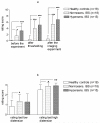Brain responses to visceral stimuli reflect visceral sensitivity thresholds in patients with irritable bowel syndrome
- PMID: 22108191
- PMCID: PMC3288538
- DOI: 10.1053/j.gastro.2011.11.022
Brain responses to visceral stimuli reflect visceral sensitivity thresholds in patients with irritable bowel syndrome
Abstract
Background & aims: Only a fraction of patients with irritable bowel syndrome (IBS) have increased perceptual sensitivity to rectal distension, indicating differences in processing and/or modulation of visceral afferent signals. We investigated the brain mechanisms of these perceptual differences.
Methods: We analyzed data from 44 women with IBS and 20 female healthy subjects (controls). IBS symptom severity was determined by a severity scoring system. Anxiety and depression symptoms were assessed using the hospital anxiety and depression score. Blood oxygen level-dependent signals were measured by functional magnetic resonance imaging during expectation and delivery of high (45 mmHg) and low (15 mmHg) intensity rectal distensions. Perception thresholds to rectal distension were determined in the scanner. Brain imaging data were compared among 18 normosensitive and 15 hypersensitive patients with IBS and 18 controls. Results were reported significant if peak P-values were ≤.05, with family-wise error correction in regions of interest.
Results: The subgroups of patients with IBS were similar in age, symptom duration, psychological symptoms, and IBS symptom severity. Although brain responses to distension were similar between normosensitive patients and controls, hypersensitive patients with IBS had greater activation of insula and reduced deactivation in pregenual anterior cingulate cortex during noxious rectal distensions, compared to controls and normosensitive patients with IBS. During expectation of rectal distension, normosensitive patients with IBS had more activation in right hippocampus than controls.
Conclusions: Despite similarities in symptoms, hyper- and normosensitive patients with IBS differ in cerebral responses to standardized rectal distensions and their expectation, consistent with differences in ascending visceral afferent input.
Copyright © 2012 AGA Institute. Published by Elsevier Inc. All rights reserved.
Figures



References
-
- Longstreth GF, Thompson WG, Chey WD, Houghton LA, Mearin F, Spiller RC. Functional bowel disorders. Gastroenterology. 2006;130:1480–91. - PubMed
-
- Svedlund J, Sjodin I, Dotevall G, Gillberg R. Upper gastrointestinal and mental symptoms in the irritable bowel syndrome. Scand J Gastroenterol. 1985;20:595–601. - PubMed
-
- Mayer EA, Naliboff BD, Chang L, Coutinho SV. V. Stress and irritable bowel syndrome. Am J Physiol Gastrointest Liver Physiol. 2001;280:G519–24. - PubMed
-
- Drossman DA, Dumitrascu DL. Rome III: New standard for functional gastrointestinal disorders. J Gastrointestin Liver Dis. 2006;15:237–41. - PubMed
-
- Craig AD. A new view of pain as a homeostatic emotion. Trends Neurosci. 2003;26:303–7. - PubMed
Publication types
MeSH terms
Grants and funding
LinkOut - more resources
Full Text Sources
Other Literature Sources
Medical

